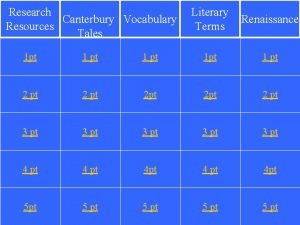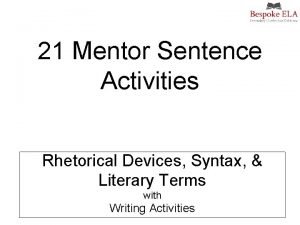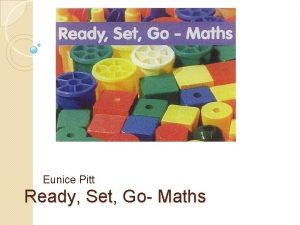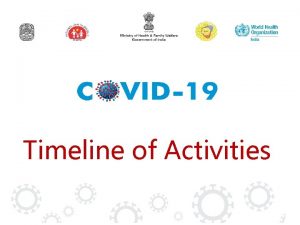Science Fair Ready Set Go Timeline and Dates















- Slides: 15

Science Fair Ready, Set, Go!

Timeline and Dates See the calendar for dates for the local and fifth grade county-wide fairs.

SCHEDULE FOR COUNTY-WIDE ELEMENTARY SCIENCE FAIR Projects must be in place at Dandridge Elementary School Library by 2: 00 on the day of the fair. Each school may send one representative for each fifth grade classroom. Students may come from any of the classrooms. Projects will be judged between 2: 00 p. m. and 4: 00 p. m.

Students will be present at their project by 4: 00 to talk to the judges about their project. Students participating in the county-wide fair will be treated to a “Pizza Party”. Awards ceremony will begin at 6: 00 p. m. All projects MUST be removed from the area immediately following the ceremony.

Students and Parents should utilize the Science Fair page on Jefferson County Schools website. On the NEW site, select Departments, then Science/STEM, then Science Fair

Role of the Teacher You are an advisor. Recognize the need for active student involvement. Respect student ideas and help steer them in the correct direction. Praise and encourage students. Advise students of resources available.

Tips for the Students A Science Fair project is an investigation – not a demonstration. There is a question that must be answered. If you have a demonstration in mind, remember to alter the thought process to asking a question: What is in _______? Why does this happen? Can I do this a better way? How does temperature change the behavior?

Components of a Project Question or Problem Hypothesis : State in an “ If – then format” Methods Materials Results – drawings, pictures, graphs, tables Conclusion DO NOT use: I, we, you!

Variables The independent variable is the one that is changed by the scientist. In an experiment there is only one independent variable. The dependent variable changes in response to the change the scientist. There should be a control No experimental treatment is applied. Constants are conditions that remain the same for all parts of the experiment, such as measuring the water, always by a window, same position in the room, etc.

Display Board Arrange information so that it is easy to read and flows in a logical order. Top to bottom and left to right.

Examples No living or dead organisms in the display (plants or animals).

Sample Materials List ( From Science Buddies) CD player & a CD (low drain device) Three identical flashlights (medium drain device) Camera flash (high drain device) AA size Duracell and Energizer batteries AA size of a "heavy-duty" (non-alkaline) battery (I used Panasonic) Voltmeter & a AA battery holder Kitchen timer

Sample Procedure ( From Science Buddies) Number each battery so you can tell them apart. Measure each battery's voltage by using the voltmeter. Put the same battery into one of the devices and turn it on. Let the device run for thirty minutes before measuring its voltage again. (Record the voltage in a table every time it is measured. ) Repeat #4 until the battery is at 0. 9 volts or until the device stops. Do steps 1– 5 again, three trials for each brand of battery in each experimental group. For the camera flash push the flash button every 30 seconds and measure the voltage every 5 minutes. For the flashlights rotate each battery brand so each one has a turn in each flashlight. For the CD player repeat the same song at the same volume throughout the tests.

Fifth Grade Science Fair Judging Rubric Jefferson County Schools Project Title: Total Points: IMPRESSIVE ADEQUATE MINIMAL Part I: SCIENTIFIC PROCEDURE Clear and Specific Questions 5 4 3 2 1 0 Clear and Specific Hypothesis 5 4 3 2 1 0 Complete & Thorough Method (step by step) 5 4 3 2 1 0 Complete & Thorough Data (logs, graphs, tables, photos, etc. ) 5 4 3 2 1 0 Conclusion Supported by Data 5 4 3 2 1 0 Conclusion Relevant to Hypothesis 5 4 3 2 1 0 Appropriate Materials and Construction 5 4 3 2 1 0 Overall Clarity of Project 5 4 3 2 1 0 Part II: ORIGINALITY Original Topic or Approach Part III: SIMPLICITY

Board Titles INTRODUCTION BACKGROUND PROBLEM HYPOTHESIS PROCEDURE DATA RESULTS MATERIALS CONCLUSION ACKNOWLEDGEMENTS • Print on Card Stock • Select the color needed • Use Rubber Cement • Use a paper cutter
 Science fair timeline
Science fair timeline Total set awareness set consideration set
Total set awareness set consideration set Training set validation set test set
Training set validation set test set Stay ready so you don't have to get ready
Stay ready so you don't have to get ready Foul is fair and fair is foul literary device
Foul is fair and fair is foul literary device Macbeth stylistic devices
Macbeth stylistic devices Foul is fair and fair is foul
Foul is fair and fair is foul Syntax literary devices
Syntax literary devices Fair play slide
Fair play slide Examples of fair is foul and foul is fair in macbeth
Examples of fair is foul and foul is fair in macbeth Sonnet 14 lines examples
Sonnet 14 lines examples When was beowulf written
When was beowulf written Ready set go transition inventory
Ready set go transition inventory Https://kahoot.it/getready
Https://kahoot.it/getready Ready set go maths
Ready set go maths Belcher elementary
Belcher elementary




























